The mysterious Polar Amplification
I do not know why, but „Climate Science“ seems to be cursed to get everything wrong, even if it is completely pointless. It puts me into an awkward position to sort out all these side shows, when there is a far more significant main line. Yet you can not really skip it, since sooner or later it would haunt you anyway. What can I say..
The Polar Amplification, what does it mean? It is pretty simple, the poles tend to heat, or cool respectively, much stronger than the rest of the planet. Something makes the climate there specifically sensitive. When we are talking about ice ages and interglacial warm periods, these were events mainly affecting higher latitudes, while temperatures towards the equator remained probably relatively stable.
I say probably, because even this question seems a bit contested. Obviously in the tropics there are no ice cores to drill for, or glaciers leaving their marks in the terrain, and there are not so many indicators on how the climate there has behaved. There is this one idea, that with ice ages the tropical (and sub-tropical) zone would only shrink, but largely maintain its climate otherwise. Alternatively there might be substantial climate variability of up to 50% of polar-, or sub-polar regions, but it would not leave too many marks behind. Who knows..
Either way, the polar amplification is real. For my part I never really cared about it, because I thought it was way too obvious what causes it. That was unless I read into the literature hereto. Surprisingly the phenomenon inspired explanations and conclusions I could not have dreamt of, and I do not mean it positively. And these issues apparently affect both sides of the discussion.
Richard Lindzen for instance makes the case for a negative feedback mechanism in the tropics, the “Iris effect”12. For some reason warm(er) tropical oceans would reduce cirrus clouds and this would then be a negative feedback, with cirrus clouds obviously having a heating effect. In this way the polar amplification would not be so much about high sensitivity there, but low sensitivity in the tropics.
John Christy, another “critical” scientist, even suggested the polar amplification would indicate global warming was not due to GHGs, but possibly of natural, or another origin.
It just doesn't look like global warming is very global.. The carbon dioxide from fossil fuels is distributed pretty evenly around the globe and not concentrated in the Arctic, so it doesn't look like we can blame greenhouse gases for the overwhelming bulk of the Northern Hemisphere warming over the past 27 years.. The most likely suspect for that is a natural climate change or cycle that we didn't expect or just don't understand.3
While I would certainly agree with the last sentence, I see no way how to derive such a position from polar, or arctic amplification. Rather such a statement suggests a lack of understanding.
The Albedo Effect
The „consensus science“ on the other side has found an explanation long ago. Ice is white, or rather the snow on it, while the ocean is dark. So if the ice melts and gives away open water, then the bulk of sun light is no longer reflected but rather absorbed, and that of course would completely change the energy balance. And as logical is it may seem, as wrong it is. At this point we need to dive a little bit into the physics.
As explained before, snow is white, but mainly so in the visible range. Beyond it, in the near infrared, this changes a lot and there snow would appear pretty dark, if we could see it. Also, as in the chart from ESA4 below, the high reflectivity with the blue curve is true for fresh snow. Older snow, consisting of larger particles, is far less reflective throughout.
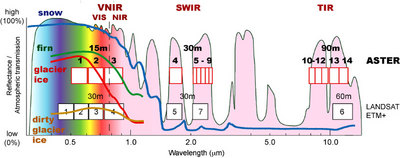
It is hard to guess one universal figure for the albedo of polar snow cover, but if we assume around 50% we might not be too far off. And that is where the other neglected problem comes in, which is the reflectivity of water. Of course we already dealt with this issue when discussing the emissivity of water. You can not simply say water is dark, when for instance the reflection of a setting sun in it can be almost blinding. With water reflectivity depends on the angle of incidence.
Going back to our Fresnel equations, and bearing in mind the sun will never rise higher than 23.44° over the horizon at the poles, we can tell reflectivity will then be between 10% and 100%. Sure this is a huge range and one might try to calculate a weighted average, not just for the pole itself, but the whole polar region. Me personally I just do not want to invest the time. The chart gives the reflectivity of water relative to the solid angle from normal for typical SW range.
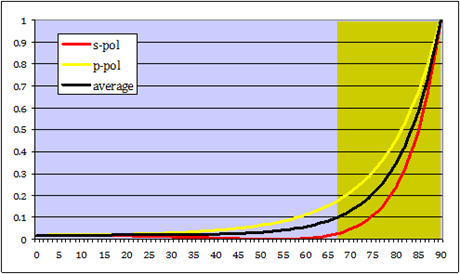
Depending on the elevation of the sun, water will either reflect more, or less light than ice. On average it is most certainly reflecting less, but the difference is not large. Given there is an abundance of clouds and solar input is naturally low, then trading all the ice for water would only yield a few W/m2.
Empirically the problem with the albedo theory is even worse. We only just need to look at the spectacular Arctic warming by the example of the last 4 years (2018-2021)5. Obviously the albedo effect can only work if the sun is shining, that is in summer. But during summer there is no warming at all. Rather all the warming is during the cold season, when there is no sun and no albedo effect.
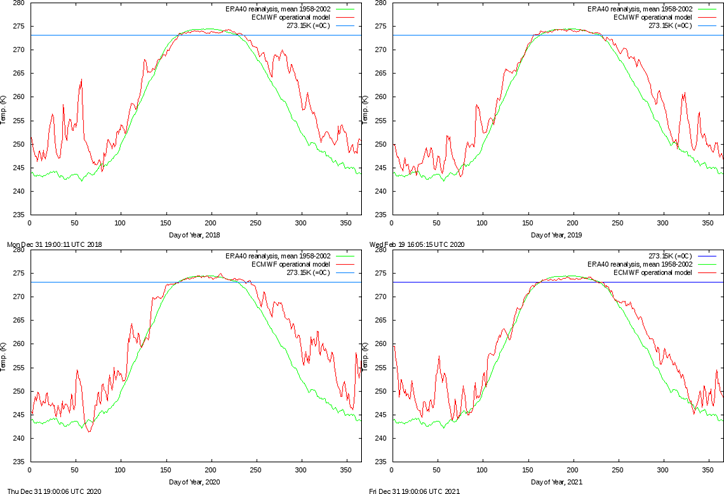
The (positive) Lapse Rate Feedback
As reality is opposing the theory, something else had to be considered. That would be lapse rate feedback. Now, as discussed, lapse rate feedback is a) negative and b) not really a feedback. However, this is not the problem here and will not rule it out as explanation for polar amplification.
Over most parts of the planet the atmosphere is warmed by the surface, which absorbs relatively more solar radiation. The warm air then ascends, providing vertical mixing, and that is essentially what makes the troposphere the troposphere. In polar winter this is no more so. With a lack of solar input, the surface turns colder than the atmosphere, resulting in an inversion. Of course it is not just the surface, but also the atmosphere close to the surface. A typical temperature profile might look like in the illustration below in blue, opposed to a simplified global average in red.
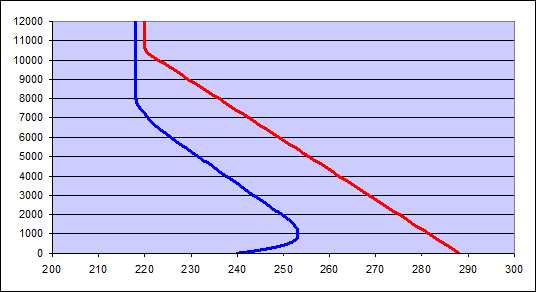
Now what happens as the Arctic warms (note, the Antarctic does not), is almost only a warming of the surface and the atmosphere right above it. The troposphere higher up barely changes at all. It is a bit hard to portray this reasonably, below is my best try (blue to purple).
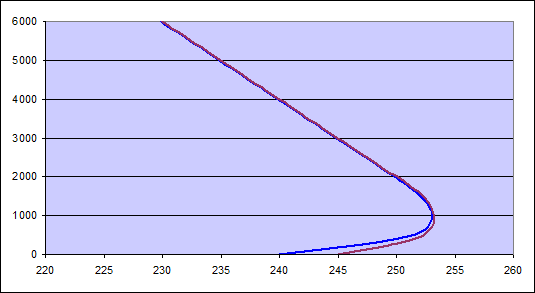
Despite the distinct shape of the atmospheric temperature profile, if you average it out, or take it as a delta between surface and top of the troposphere temperature, then the lapse rate increases as the surface warms. The larger the lapse rate, the larger the GHE. This is all the logic behind (positive) lapse rate feedback. Per se it might make a sound explanation.
Yet there is just one problem. An isolated increase in surface temperature here necessarily increases the lapse rate. If a causes b, then b will not cause a. I know, “climate science” likes to confuse such logical restrictions by arguing with “feedbacks” all the way. Even if a causes b, maybe b will then influence a again, and everything is interconnected and blah blah. Eventually everything can be argued with everything, which is great for totalitarianism, but not so good for science.
As before, a positive lapse rate feedback will neither explain why the warming occurs in the cold season, and spares out Arctic summer. But at least we have one remarkable hint. Lapse rate feedback seems to be somehow related to melting sea ice6.
This close tie between the lapse-rate feedback and sea ice loss is consistent with previous work documenting the nonlinear interactions between the feedbacks..
Collecting these results, the across-model correlation between Δ(TS − TA) and the lapse-rate feedback indicates that the surface-atmospheric temperature difference corresponds to the intermodel spread—driven by surface, not atmospheric, temperature change.
Given this evidence, we argue that the lapse-rate feedback is a seasonal and regional phenomenon governed by the multiple processes that generate surface-based warming.
Rather, Arctic Amplification and the intermodel spread should be attributed to the physical processes responsible for the nonuniform warming profile (surface albedo, water vapor, and cloud feedback, surface turbulent fluxes, and ocean heat storage)
Well, I will not deny the quoted paper is on to something. It sounds all really complicated and “scientific”. Essentially they wonder why lapse rate feedback would be so strictly related to sea ice loss and what the mystery behind it is all about. Sure there must be many factors in play.
The Solution
All kidding aside, there is a far more simplistic explanation, which, for whatsoever reasons, “the science” does not want to consider. By latitude Earth receives different amounts of solar energy. Relative to the persisting temperatures (and LW emissions), the tropics receive a surplus in solar energy, high latitudes and specifically the poles, have a deficit. Obviously heat is then transported from the tropics to higher latitudes, balancing surplus and deficit respectively. This meridional heat transfer so far is undisputed.
Things get odd once you start googling “maritime climate”, or “oceanic climate”. We all know what it is. The presence of water moderates air temperatures, due to the large heat capacity of water. That is opposed to a continental climate where temperatures are far more extreme. As familiar the phenomenon is, you would expect plenty of reasonable explanations to it, starting with Wikipedia7. There a maritime climate is somehow caused by.. jet streams?! No, I am not kidding!
Also I have scanned the IPCCs AR5, which spends not a single phrase on maritime- or oceanic climate. It is too trivial to deal with, I assume. With such negligence of the phenomenon, it is hard to quote any sources hereto. I am not even certain over what is the correct technical term. Is it water to air convection? The terminology should not matter, so please do not crucify me should I be wrong.
Anyhow, water temperature is dominating air temperature. We have countless and impressive examples for it. For instance we have Trondheim in Norway (63N) and Yakustk in Siberia (62N), both at similar latitudes. In January Trondheim has an average moderate -1°C, while Yakutsk has -37°C. It is a huge difference, given the sun is not to blame here. And although Trondheim specifically benefits from the Gulf Stream, this only makes up for a few Centigrade. Despite Yakutsk being a little bit warmer during summer, it is still 14°C colder throughout the year. The extreme cold winter just dominates the average.
Given the Artic has an energy deficit, especially during winter of course, oceanic convection is not enough. The heat also has to arrive at the surface, which is no problem as long as there is water. But this process can be interrupted by sea ice. Sea ice does insulate the surface from the relatively warm water. The more sea ice there is, the larger the frozen area, the more continental the climate will be. As with the example above, the impact on surface temperatures can be huge.
Indeed Arctic sea ice has declined sharply over the last decades. The chart below8 not shows the area covered, but rather sea ice volume. This is probably a better measure, as the insulating effect will also depend on its thickness. Over the last 4 decades about 40% of Arctic sea ice got lost and accordingly the climate has transformed from as continental as it was, to half way maritime.
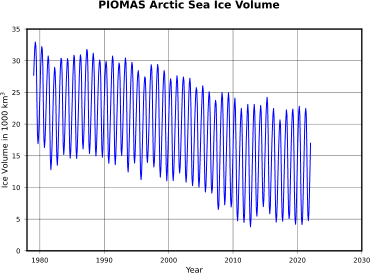
As to be expected, this will not yield a warming during summer. Even without ice, the water is barely above freezing and will hold down summer temperatures. Also then temperatures are extremely stable and tight, barely deviating by more than 2°C. On top of that, this non-warming summer is a remarkable exception to the otherwise “global warming” in the northern hemisphere, that of course does not exempt the summer. This detail alone should ring the alarm bells.
In winter on the other side, with yet a large iced area, temperatures are volatile. With the water-air convection providing little heat, what determines surface temperature is largely atmospheric convection. In other words, it is all about from where the wind is blowing. It can be mild Atlantic air, or a pocket of extra chilly Siberian air. Yet as the ice declines, the Arctic becomes less Yakutsk and more Trondheim, so to say. In winter this makes a huge difference with a warming of over 5°C already. I am certainly not alarmist, but that much warming is truly impressive.
I think all this straight forward and easy to understand. I could call it a theory, but honestly it just as much theory as 1 + 1 = 2. It is just way too obvious. And of course this mechanism is not restricted to the current development in the Arctic, rather it will work just as well in the Antarctic. Despite the continental land masses, there is also a large area of sea ice surrounding it, equally amplifying any warming trend, if there was one in the first place.
Also we can imagine how this played out in paleoclimate. During ice ages large high latitude areas were essentially cut off from oceanic heat convection. Their radiative deficits were no longer supplemented. Of course they fell into deep winter. Also as ice moves towards more moderate latitudes even a significant albedo effect kicks in. Then with less circulation the remaining heat will be more concentrated in the tropics, serving as a kind of negative feedback, thereby even enhancing polar (or peripheral) amplification.
Why does “the science” ignore it?
The big question remains, why is this not being considered? As a rule you shall not assume conspiracy when incompetence is an option. While I will NEVER rule out incompetence in “climate science”, conspiracy seems more reasonable in this instance. There is one significant difference between albedo- and lapse rate feedback on the one side, and water-air convection on the other side. The latter is only just about the distribution of heat, without adding to, or removing energy from the system. The former two though support an alarmist narrative and add to climate sensitivity.
With the albedo effect Earth as a whole absorbs more radiation, heating the planet even further. With the lapse rate effect, more energy is retained, again adding heat to the whole system. With these narratives the Arctic (or polar-) amplification turns into a kind of tipping point. Just point out the truly dramatic warming there (do not tell it is in winter but not summer, to avoid questions), add some starving polar bears to it, and you can tell a really nice and dramatic story.
Summary
Well yes, polar amplification is not rocket science. Of course sea ice is largely responsible for it by cutting off water to air convection. As if this was not obvious enough, the pattern of polar amplification perfectly fits the fact, while it contradicts the forced theory-building in the “climate science” community.
To the alternative theory-builders out there it shall be said, a) the polar amplification is real, it happens at the poles (and beyond), and it is not masked by climate insensitivity in the tropics. And b) it does not contradict the theory of GHG induced AGW, not per se. Once more a relatively simple issue is subject immense speculation and theory building, representing different interests, rather than sober analysis.


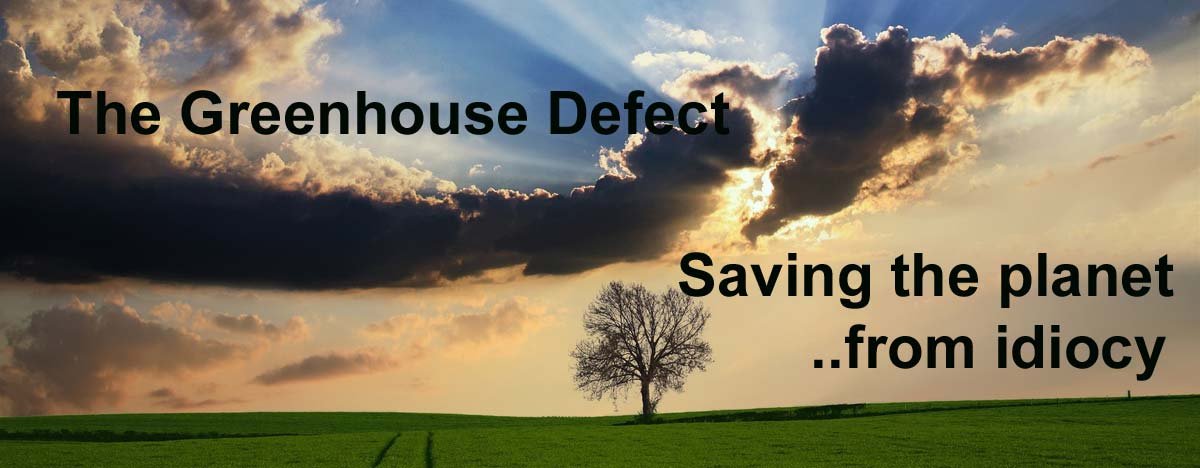
Comments (0)
No comments found!